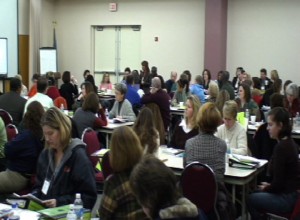We were so impressed by Jamila Riser’s talk at NCSM a couple of years ago that we asked her to present an Ignite! for us this year. Now, we’ve asked her to guest blog so we can share even more about the amazing work she’s doing in Delaware. Jamila is the Director of the Delaware Mathematics Coalition and one of the leaders in her state who is driving change through P-Cubed (Powerful Pedagogical Practices).
The Delaware Mathematics Coalition and its higher education partner at the University of Delaware were fortunate to have one of the lead architects for the Common Core State Mathematics Standards, Bill McCallum, at our recent summer professional development institute.

McCallum led participants of the Coalition’s Toward A New Normal in High School Mathematics Institute in a discussion of the meaning and use of the Common Core State Standards. “We teach mathematics, not individual standards,” shared McCallum.
McCallum then referenced an analogy from his blog in which the authors of the Common Core compared the use of standards to the shipment and handling of a priceless Grecian urn. He cautioned the audience members against tearing the Standards apart and attempting to reference each of the bullets in their daily lessons.
Delaware, like most of the states in this country, has adopted the Common Core State Standards. In many respects, the adoption of the Standards has provided us with an opportunity to “reboot” our mathematics reform efforts. Very recently, for example, the majority of the public high schools in the state have adopted the current editions of the Interactive Mathematics Program (IMP) or the Core Plus Mathematics Program (CPMP). In that regard, we believe we are extremely well poised to exemplify the spirit and power inherent in the Common Core State Standards, particularly the Standards of Mathematical Practice.
No question, our foremost goal continues to be empowering students to be “users” of mathematics—to see the beauty and relevance of mathematics in their daily lives. To that end, we are certain we are headed in the right direction. But if we aren’t careful, our efforts to align the curriculum with the Standards may in fact undermine and unravel the very thoughtfully written, research-based programs we have adopted. It may be all too easy to become distracted and focus on the pieces rather than the broader goal of creating mathematically competent and literate citizens. As McCallum noted during his discussion with our teachers, teaching mathematics is a very complex endeavor.
In our efforts to “meet the Standards” we may naively rearrange or omit important portions of the curriculum in the name of Standards. In doing so, we may inadvertently or unconsciously compromise the integrity of these programs; undermining the intentions of the authors. The authors and publishers didn’t attempt to appeal to the consumer by simply adding a new stamp to their cover saying “Common Core State Standards Aligned!” These materials were extensively researched, tested, and revised based on their use with students, teachers, and professional reviewers.
Certainly there is a need to re-examine our current approach to teaching mathematics. We continue to fall far short of genuinely engaging the vast majority of our secondary students in rich, meaningful, and substantially enduring mathematical experiences. The consequences of our shortcomings are apparent not just to the public educator, but also to the average American, who recognizes all too well our failure to promote and produce substantial numbers of students who want to pursue STEM-centric studies and careers upon graduation from high school.
Let’s define the creation of the Standards as both an opportunity and a challenge. Let’s refuse to allow obstacles to stand in our way of critically re-examining our approach to engage students in learning significant mathematics.
It’s time to challenge ourselves to stand up for our students, confront our notions about teaching and learning in conventional ways, and seize the opportunity to fundamentally transform the way we approach teaching mathematics in our K–12 and post-secondary institutions!